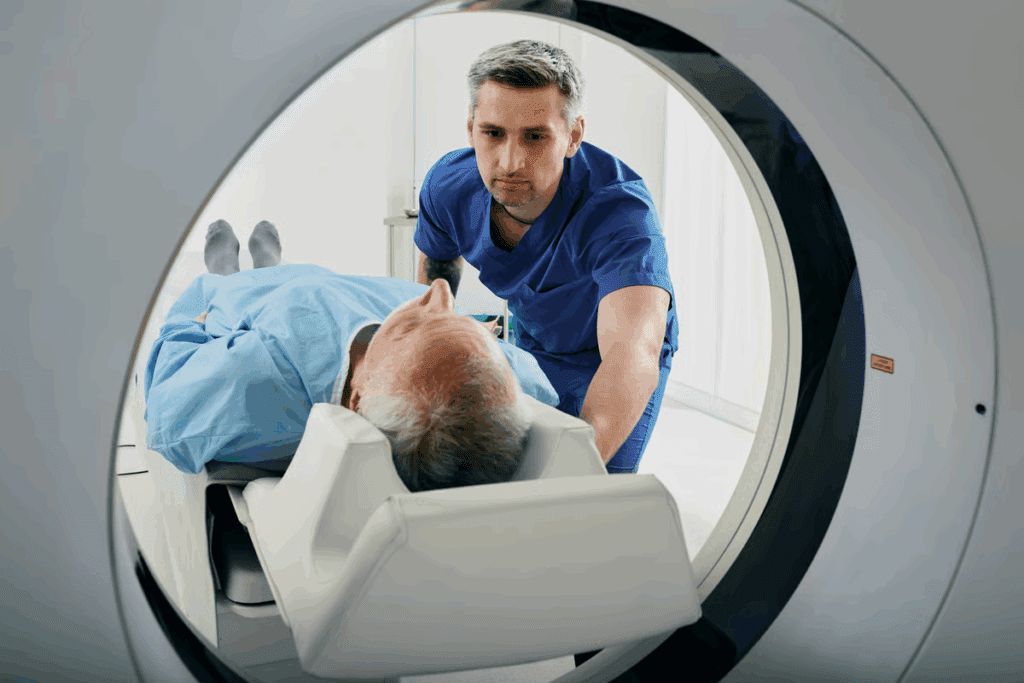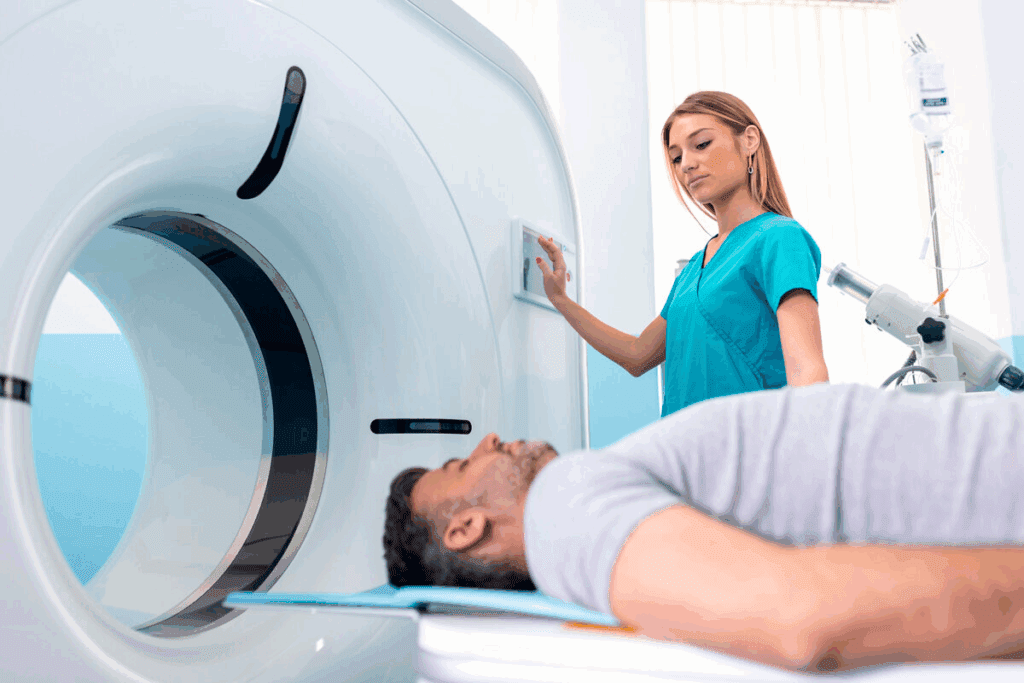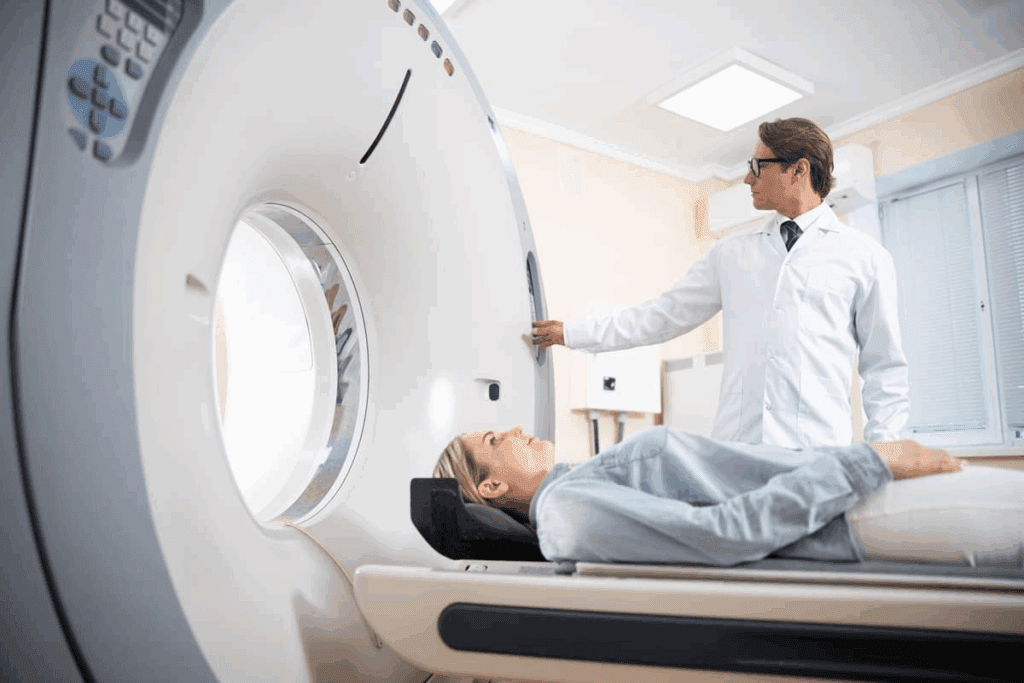Last Updated on November 26, 2025 by Bilal Hasdemir

Getting a quick and accurate diagnosis of bowel obstruction is very important. CT scans are now the top choice for spotting this issue. They are super accurate, with a success rate over 90%.
This high accuracy comes from specific signs seen on the scans. These include big loops of small bowel and the ‘small bowel feces sign.’
Learn what bowel obstruction on ct scan shows and how doctors diagnose blockages quickly.
CT scans give doctors clear pictures. This helps them quickly find where the blockage is. Knowing this is key to figuring out the best treatment.

CT scans are key in diagnosing intestinal obstruction. They show where and how bad the blockage is. Their detailed images are vital for checking the condition.
Bowel obstruction happens when something blocks the intestine. This blockage can be physical or caused by other issues. Knowing how it works helps doctors understand CT scan results.
The changes in bowel obstruction include:
CT scans spot these changes. They help doctors diagnose and see how severe the blockage is.
CT scans beat other imaging methods in diagnosing intestinal obstruction. They offer:
Using CT scans to diagnose intestinal obstruction is now common. Their accuracy and detailed info make them essential.

Improving CT scan protocols is key for accurate bowel obstruction diagnosis. The technical details of CT scans greatly affect their ability to diagnose.
Multidetector CT technology has changed diagnostic imaging. It offers faster scans, clearer images, and detailed views of the bowel. This technology boosts diagnostic accuracy and helps spot bowel obstruction complications.
Multidetector CT scanners take multiple slices at once. This lets radiologists see the bowel in more detail. It’s great for finding where and why the bowel is blocked.
Choosing between contrast and non-contrast CT scans is important for patients with kidney issues. Studies show both contrast-enhanced and non-contrast scans work well for bowel obstruction detection. The choice depends on the patient’s kidney health and other health conditions.
| Protocol | Renal Function | Diagnostic Accuracy |
| Contrast-Enhanced | Normal | High |
| Non-Contrast | Compromised | High |
Adjusting imaging settings is vital for spotting bowel obstruction on CT scans. Settings like slice thickness, reconstruction interval, and tube current affect image quality and accuracy.
By fine-tuning these settings, radiologists can better detect bowel obstruction and its complications. This helps in making the right treatment choices.
Dilated bowel loops are a key sign in diagnosing bowel obstruction. They help doctors tell apart blocked and normal parts of the bowel.
Small bowel loops are considered dilated if they are over 2.5 cm in diameter. Loops this large often show signs of obstruction.
A dilation over 2.5 cm is a big sign of small bowel obstruction. This size is important for doctors to spot possible blockages.
Clinical Relevance: Spotting dilated loops early is key for quick treatment. Radiological experts say, “Finding dilated bowel loops on CT scans is vital for diagnosing small bowel obstruction.”
The way loops dilate gives clues about where and why the obstruction is happening. Loops dilating closer to the start of the blockage often mean the blockage is further down. Loops dilating closer to the end might point to a more complex or partial blockage.
“The pattern of bowel dilation on CT scans not only aids in diagnosing obstruction but also helps in understanding the underlying etiology.”
Grasping these patterns is essential for making the right diagnosis and treatment plan.
The transition point is where the bowel changes from being dilated to decompressed. It’s a key feature in diagnosing bowel obstruction on CT scans. Finding this point accurately helps understand the cause and severity of the obstruction.
The transition zone shows a sudden change in bowel size. On CT scans, this change is clear. It might also show a change in bowel wall thickness or how it looks under the scan.
The look of the transition zone on scans can tell us a lot. For example, a gradual narrowing might point to adhesive or inflammatory causes. But an abrupt stop could mean a mechanical blockage, like a hernia or tumor.
Knowing why the bowel is obstructed is key for treatment. The transition point’s look on CT scans can hint at the cause. For example, a mass or inflammation might suggest a tumor or inflammation.
Clinical Correlation: It’s important to match CT findings with the patient’s symptoms and history. For example, someone with a history of surgery and no mass might have adhesive obstruction.
Being able to spot and describe the transition point on CT scans is a must for doctors and radiologists. By looking at the transition zone and the patient’s history, healthcare teams can make better treatment plans for bowel obstruction.
Seeing the “small bowel feces sign” on CT scans helps doctors diagnose bowel obstruction. This sign shows fecal-like material in the small bowel. It’s unusual because feces usually come from the colon.
On CT scans, fecalization in the small bowel looks like feces. It’s caused by the buildup of intestinal contents. This buildup absorbs water, making the contents look like feces.
The “small bowel feces sign” often shows how long an obstruction has been there. Chronic obstructions give more time for water absorption. This leads to the fecalization of small bowel contents.
The following table summarizes the correlation between the “small bowel feces sign” and obstruction chronicity:
| Obstruction Chronicity | Likelihood of “Small Bowel Feces Sign” |
| Acute | Less likely |
| Subacute | Possible |
| Chronic | More likely |
In conclusion, the “small bowel feces sign” is a key clue on CT scans for bowel obstruction. It suggests the obstruction might be chronic.
The fourth key feature in diagnosing bowel obstruction involves examining mesenteric changes and vascular findings on CT scans. These features are key as they show signs of complications like ischemia or strangulation.
Mesenteric edema and congestion are important signs seen on CT scans. Mesenteric edema is when the mesenteric fat swells, often due to inflammation or blockage. This swelling can put pressure on nearby structures, which might harm the bowel.
Mesenteric edema shows up as increased attenuation in the mesenteric fat on CT images. The swelling can range from a bit hazy to very swollen. Congestion, or engorgement of the mesenteric vessels, is a sign of venous blockage or high pressure in the mesenteric circulation.
The patterns of mesenteric edema and congestion give clues about the cause of bowel obstruction. Localized changes might point to a specific issue like a hernia or localized inflammation. But widespread changes suggest a broader problem.
Vascular engorgement is a critical finding on CT scans for bowel obstruction. It’s when blood vessels in the mesentery get bigger, often due to blockage or inflammation. This is a warning sign for possible complications like ischemia or strangulation of the bowel.
Seeing vascular engorgement, along with other signs like mesenteric edema or bowel wall thickening, means you need to act fast. Spotting these changes on CT scans is key for quick action in managing bowel obstruction.
CT scans are key in figuring out how serious a small bowel obstruction is. This is important for choosing the right treatment. Radiologists and doctors need to know how to tell the difference between a high-grade and partial obstruction on CT scans.
When grading small bowel obstruction on CT scans, several things are looked at. These include how swollen the bowel is, if there’s a clear blockage point, and what the bowel and its surrounding tissue look like. High-grade obstructions show a lot of swelling in the bowel, a clear blockage point, and signs of the bowel not getting enough blood or dying.
Partial obstructions have less swelling and a less clear blockage point. The bowel and its surrounding tissue look pretty normal, showing a less serious blockage.
The seriousness of a small bowel obstruction matters a lot. High-grade obstructions need quick action, like surgery, because of the risk of serious problems like bowel not getting enough blood or bursting.
Partial obstructions might be treated with rest, fluids, and suction through the nose first. But, they need to be watched closely because they could get worse and become high-grade obstructions.
Doctors need to understand how serious a small bowel obstruction is to make the right decisions for patients. CT scans give them the info they need to decide on treatment and if surgery is needed.
Closed-loop obstructions are a serious issue in small bowel obstruction. They need quick diagnosis and treatment. These obstructions happen when a part of the intestine is blocked at two places. This can cause ischemia and strangulation if not treated fast.
Closed-loop obstructions are very dangerous. They can cut off blood supply to the intestine. The risk of strangulation and ischemia makes it very important to find them quickly.
CT scans help find signs of blood problems in closed-loop obstructions. Important signs include:
These signs show blood problems and the need for quick surgery.
The “whirl sign” is a key sign on CT scans for closed-loop obstructions. It shows the mesenteric vessels and intestine swirling around a fixed point, usually the obstruction site. This sign means there’s a high chance of strangulation.
“The ‘whirl sign’ on CT scans is a critical indicator of closed-loop obstruction, warranting immediate attention due to its association with bowel ischemia and strangulation.” – Expert in Radiology
In summary, finding closed-loop obstructions on CT scans is very important because of the risk of strangulation. Signs like the “whirl sign,” mesenteric edema, and reduced bowel wall enhancement are key. Quick spotting of these signs is vital for timely treatment and avoiding serious problems.
The seventh key feature in diagnosing bowel obstruction is finding its cause. Knowing the cause is key for the right treatment.
Adhesions are the top reason for small bowel obstruction, often from past surgeries. CT scans are key in spotting adhesions, but they can be tricky. They show signs like a sudden change in the bowel without a clear mass.
Table: Common Causes of Small Bowel Obstruction
| Cause | Frequency | CT Scan Findings |
| Adhesions | 60-70% | Abrupt transition, no mass |
| Hernias | 10-15% | Hernia orifice, bowel protrusion |
| Masses/Tumors | 5-10% | Mass lesion at transition point |
| Inflammatory Causes | 5% | Mural thickening, inflammation |
Hernias, masses, and inflammation are also big causes of bowel obstruction. Hernias show up on CT scans as the orifice and bowel protrusion. Masses and tumors block the bowel by taking up space, seen as a mass at the transition point.
Inflammatory issues like Crohn’s disease can also cause obstruction. CT scans show how much inflammation there is and any complications.
Knowing the cause is vital for doctors and radiologists to give the right diagnosis and treatment plan.
Getting a correct diagnosis of bowel obstruction is key for good patient care. CT scans are very important in this process. They give detailed images that help find where and why the obstruction is happening.
The 7 key imaging features talked about in this article are vital for spotting bowel obstruction on CT scans. They help doctors understand the situation better.
By using CT scan results, doctors can make better choices for patient care. This can lower the chance of complications and make treatment more effective.
Using CT scan results well helps doctors create specific treatment plans. This makes patient care better and leads to better results for patients.
CT scans are key in diagnosing bowel obstruction. They are very sensitive and specific. This allows for quick diagnosis and treatment.
CT scans give detailed images of the bowel and surrounding tissues. They can detect complications. This makes them a top choice for making management decisions.
Multidetector CT technology improves image quality. Contrast protocols can be adjusted for patients with kidney issues. This helps in making accurate diagnoses.
Dilated bowel loops are a key sign. A diameter over 2.5 cm may indicate obstruction. The pattern of dilation helps find where and how severe the blockage is.
The transition point is found by its look on the scan. Knowing its characteristics helps figure out the cause of the blockage.
The “small bowel feces sign” shows fecal material in the small bowel. It’s a sign of chronic obstruction. It’s seen on CT images.
Bowel obstruction is linked to mesenteric edema, congestion, and vascular engorgement. These signs warn of possible complications.
CT scans use specific criteria to grade obstruction severity. This helps guide treatment based on the obstruction’s level.
A closed-loop obstruction is a serious blockage where a bowel loop is blocked at two points. It’s identified by signs of vascular compromise, like the “whirl sign,” on CT scans.
CT scans can spot various causes of bowel obstruction, like adhesions, hernias, and masses. Some causes might be harder to find.
Whether to use contrast or non-contrast CT scans depends on the patient’s condition and what’s needed for diagnosis.
CT scans are often the first choice for diagnosing small bowel obstruction. They provide detailed images and can spot complications.
The severity of bowel obstruction as seen on CT scans affects treatment choices. Severe obstructions usually need quicker action.
Subscribe to our e-newsletter to stay informed about the latest innovations in the world of health and exclusive offers!